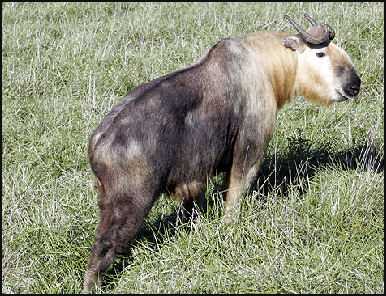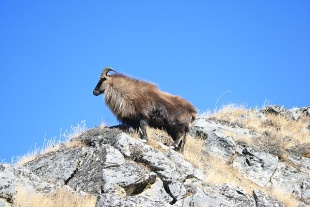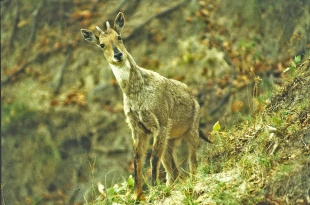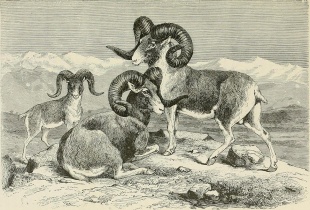TAKIN

Takin, lives in same area as golden monkey The Takin is an odd-looking cow-goat-like animal with musk-ox-style horns that is found in mountainous areas with forest and shrub growth in the eastern Himalayas and western China in Sichuan, Yunnan and eastern Tibet at an altitude of 2000 to 5,000 meters. There are four subspecies: 1) the Mishmi Takin; 2) the Shanxi or golden takin; 3) the Tibetan or Sichuan takin; and 4) the Bhutan Takin. Mitochondrial research shows that takin are related to sheep, its similarity to the musk ox being an example of convergent evolution.
Takin (Budorcas taxicolor) also called cattle chamois and gnu goats, are ungulates. They are rare animals found mostly in the intersecting mountain ranges of the eastern Himalaya. Adult takin have a head and body length of 1.7 to 2.2 meters (5.7 to 7.3 feet), not including the stubby 12- to 21-centimeter tail, and stands one meter to 1.3 meters meters at the shoulder. They weigh up 350 kilograms (790 pounds), with females generally weighing around 200 kilograms; and males weighing 300-330 kilograms. Their strong horns may reach 95 centimeters (38 inches) in length. Both males and females have horns which grow outward before curbing backward and then upward, sort of like the horns of a musk ox. Females tend to be smaller than males.
The takin is the national animal of Bhutan. In China, they are listed as a seriously threatened species in danger of extinction Their preferred habitats there are forests and marshy grassland in high and middle mountains. They eat all kinds of tree leaves and grass. They can be found in the Hengduan Mountain in West Yunnan and the Qinling Mountain in Northwest China. The species lives in Qinling area of Shanxi are yellow or golden. While the species lives in Southeast of Tibet and West Yunnan are deep brown. In western China, Takin are relatively easy to find on the Qinling Mountains between Sichuan and Shaanxi provinces, because of State protection and no competitors in the wild. [Source: Center of Chinese Academy of Sciences, kepu.net.cn]
The takin rivals the musk ox as the largest and stockiest of the subfamily Caprinae, which includes all goats, sheep and similar species. Short legs are supported on large, two-toed hooves, which have a highly developed spur. The chest is deep. The large head is made more distinctive by the long, arched nose, and stout horns that are ridged at the base. Their combination of features has also earned them the nicknames "cattle chamois" and "gnu goat". [Source: Wikipedia]
Good Websites and Sources: China.org article on Tibetan animals china.org.cn ;Animal Info animalinfo.org/country/china
See Separate Article: TAKIN: CHARACTERISTICS, BEHAVIOR AND REPRODUCTION factsanddetails.com
RECOMMENDED BOOKS: “Himalayan Wildlife: Habitat and Conservation” by S. S. Negi Amazon.com; “Stones of Silence” by George Schaller Amazon.com; “Wild Animals of India, Burma, Malaya and Tibet” by Richard Lydekker Amazon.com ; “Chinese Wildlife” ( Bradt Travel Wildlife Guides) by Martin Walters Amazon.com Amazon.com; “Birds of the Himalayas” (Pocket Photo Guides) by Bikram Grewal and Otto Pfister Amazon.com “Wildlife of India” by Bikram Grewal Amazon.com; “Tibet's Hidden Wilderness: Wildlife and Nomads of the Chang Tang Reserve by George B. Schaller Amazon.com “Chang Tang A High and Holy Realm in the World” by Liu Wulin Amazon.com “Big Open: On Foot Across Tibert's Chang Tang” by Rick Ridgeway , Galen Rowell, et al. Amazon.com; “The Chiru of High Tibet: A True Story” by Jacqueline Briggs Martin and Linda Wingerter Amazon.com; “Contesting Conservation: Shahtoosh Trade and Forest Management in Jammu and Kashmir, India” by Saloni Gupta Amazon.com
Himalayan Tahr
Himalayan tahr (Hemitragus jemlahicus) are also known common tahr. Sure-footed, with a shaggy, conspicuous mane on their neck and shoulders, they are a large ungulate related to wild goat sand the only extant member of the genus Hemitragus. They make their homes in the rugged wooded hills and mountain slopes in the Himalaya in Nepal, Bhutan, northern Kashmir in India and Pakistan and Tibet in China. Himalayan tahrs spends the summers grazing in high pastures, coming down to lower elevations and forming mixed-sex herds in the winter. [Source: Wikipedia]
Himalayan tahr are herbivores, mainly eating grass, shrubs, and tree parts. They graze mostly in the morning and evening and rest in the middle of the day in a quiet, hidden place. In the wild, tahr can live up to 15 years, though ten years is more typical. Males and females with their young live in separate groups, which join in the mating season.
There are three species, all native to Asia. 1)the Arabian tahr (Arabitragus jayakari) of Oman; 2) the Nilgiri tahr (Nilgiritragus hylocrius) of South India and the Himalayas tahr. Arabian tahrs Nilgiri tahrs both have small ranges and are considered endangered, Previously they were thought to be closely related to each other and placed in a single genus, Hemitragus. However, genetic studies have since shown they are not so closely related and they are now considered as members of three separate monotypic genera: Hemitragus for the Himalayan tahr, Nilgiritragus for the Nilgiri tahr, and Arabitragus for the Arabian tahr.
See Separate Article: HIMALAYAN TAHR: CHARACTERISTICS, BEHAVIOR AND REPRODUCTION factsanddetails.com
Bharal (Blue Sheep)
Bharal (Pseudois nayaur) also called blue sheep. A kind of caprine (goat) native to the high Himalayas and the only member of the genus Pseudois, they are found Nepal, Pakistan, India, Bhutan, Myanmar, and in China in the provinces of Gansu, Ningxia, Sichuan, Tibet, and Inner Mongolia. The Helan Mountains of Ningxia have the highest concentration of bharal in the world, with 15 bharals per square kilometers and 30,000 in total. [Source: Wikipedia]
The name "bharal" is derived from the Hindi word for "blue sheep", in turned fron the bluish sheen on their coats when they are juveniles. The scientific name Pseudois nayaur means "false sheep" due to some of the the animal's features ("nayaur" is thought to originate from the Nepali word for sheep). Native native names for bharal include yanyang in Mandarin; bharal, barhal, bharar, and bharut in Hindi; na or sna in Tibetan and Ladakh; nabo in Spitian, naur in Nepali and na or gnao in Bhutan. Bharal were the subject of a famous expedition and study by George Schaller and Peter Matthiessen in Nepal in 1973 documented by Matthiessen’s book, “The Snow Leopard”. Bharal are a major prey of snow leopards.
The bharal’s mixture of sheeplike and goatlike traits have created confusion about the evolutionary relationships of this species. In 1998, Schaller wrote: "They lack beards and calluses on the knees, they have no strong body odor and the females have small, almost nonfunctional horns, all characters typical of sheep." However, "they resemble goats in their flat broad tail with a bare ventral surface, the conspicuous markings on the forelegs, and the large dew claws," the structure and color of the horns are also the same as in goats. Schaller concludes that they are goats with sheeplike traits. Molecular evidence apears to bear that out.
See Separate Article: BHARAL (BLUE SHEEP): CHARACTERISTICS, BEHAVIOR AND REPRODUCTION factsanddetails.com
Himalayan Gorals
Himalayan gorals (Naemorhedus goral) are also known as grey gorals. They live in forests, scrub-covered slopes, bare rocks and mountain cliffs throughout the Himalayas and Karakorum mountains at elevations from 1,000 to 4,000 meters (3,281 to 13,123 feet) from Pakistan through Nepal and northern India to Bhutan. In China they can be found in Sichuan, Yunnan and Eastern Tibet.
On the International Union for Conservation of Nature (IUCN) Red List Himalayan goral are a are listed as Near Threatened. In CITES (Convention on International Trade in Endangered Species of Wild) they are in Appendix I, which lists species that are the most endangered among CITES-listed animals and plants. On China’s National List for Specially Protected Wild Animals, they are listed as a threatened species. [Source: Eric Cohen, Animal Diversity Web (ADW) /=]
Himalayan gorals are threatened by habitat loss and hunting. They have traditionally been for meat, wool, and hides. Their blood was used in some folk medicine. As humans construct roads deeper into the mountains of the Himalayas, build dams, and log forests Himalayan gorals lose habitats and have their behavior disrupted as their isolation is compromised. Additionally, advances in weapon technology have allowed hunters to kill gorals from farther distances away.
See Separate Article: HIMALAYAN GORALS: CHARACTERISTICS, BEHAVIOR AND REPRODUCTION factsanddetails.com
Argali
Argali (Ovis ammon) are the world’s largest sheep. Also known as mountain sheep, they are native to the highlands and mountains of Central Asia, the Himalayas, Tibet, and the Altai region. They weigh between 43 and 356 kilograms (95 to 729 pounds) and have a shoulder height of 85 to 135 centimeters (three to four feet) . North American bighorn sheep may approach comparable weights but are normally considerably to be slightly smaller than by the argali. Argali have large corkscrew-shaped horns with rounded combat edges similar to those of North American bighorn sheep. Both males and female argali have horns. The horns of males can be up to 1.9 meters (six feet) in length when measured along the coil. Those of females are smaller.
Currently nine subspecies of argali are recognized: 1) Altai argali, (Argali ammon); 2)Karaganda argali, (Argali collium); 3) Gobi argali, (Argali darwini); 4) Tibetan argali, (Argali hodgsoni); 5) North China argali, (Argali jubata); 6) Tian Shan argali, (Argali karelini); 7) Kara Tau argali, (Argali nigrimontana); 8) Marco Polo argali, (Argali polii); and 9) Severtzov argali, (Argali severtzovi). Subspecies are distinguished by seasonal age related fur differences, body size and geographic location. /=\
The lifespan of Argali sheep averages 10 to 13 years, with the oldest being about 20 years old. Predators and extreme climatic conditions kill older sheep, so maximum lifespan is seldom achieved. Males can generally live longer than females. [Source: John Tonda, Animal Diversity Web (ADW) /=]
See Separate Article: ARGALI; CHARACTERISTICS, BEHAVIOR AND REPRODUCTION factsanddetails.com
Marco Polo Sheep
Marco Polo sheep (Ovis ammon polii) are subspecies of argali, named after Marco Polo. They are found mainly in the Pamir Mountains region adjacent to the borders of Afghanistan, Pakistan, Kyrgyzstan, Tajikistan and China. They are generally found at elevations from 3,700 to 4,800 meters (12,100 to 15,700 fet). They are found in the greatest numbers in Pakistan in the northwestern part of the Hunza district along the Chinese border, where they inhabit the Kilik Mintaka border and the northwestern area of Khunjerab National Park. Marco Polo sheep also inhabit the Wakhan Corridor, along the Afghanistan border. They share much of their habitat with animals such as the Siberian Ibex. [Source: Wikipedia]
Marco Polo sheep are also known as Marco Polo's argali and Pamir argali. They are named after the 13th century explorer Marco Polo because he described them in his book The Travels of Marco Polo after witnessing them in the Pamirs before his arrival in China. The Marco Polo subspecies was first described scientifically by zoologist Edward Blyth in 1841. Marco Polo sheep are distinguishable mostly by their large size and spiraling horns, which resemble those of North American big horn sheep. Their conservation status is "near threatened" and efforts have been made to protect their numbers and keep them from commercial hunting. It has also been suggested that crossing them with domestic sheep could have agricultural benefits.
Marco Polo sheep are particularly known for their long, spiraling horns which may reach an uncoiled length of 1.4 meters (3.75 feet). They have the longest horns of all sheep, with the longest individual horn ever recorded — measuring 1.9 meter (6.2 feet) and weighing 60 pounds (27 kilograms). Marco Polo sheep horns follow a coil pattern, with the tips pointed directly away horizontally from the head; in spite of this, the tips are rarely broken. The horns have long been a popular attraction for trophy hunters. They begin growing 15 to 20 days after the sheep are born. Their growth in length is most pronounced during the first year. Thickness growth is most noticeable during the first two years.
See Separate Article: ARGALI; CHARACTERISTICS, BEHAVIOR AND REPRODUCTION factsanddetails.com
Himalayas (Siberian) Ibex
Siberian ibex (Capra sibirica) are also known as Asian ibexes. Inhabiting long and vast mountain systems of the central Asian deserts and the northwestern Himalayas, they stand .8 to one meter (2.5 to 3.3 feet) at shoulder, and weighs an average 60 kilograms (132 pounds. Adult males have long pointed beards and scimitar-shaped horns with prominent ridges on the frontal surface. Their coat is dark brown with greyish underparts. A stripe runs across the back from neck to tail. Adult males also have grey saddle patches on their backs. Females are smaller with small straight horns that are widely separated at the base. Siberian ibex are widely distributed over an area stretching from the Hindu Kush Mountains in Afghanistan to Sayan Mountains in Mongolia. They animals are found most often at elevations ranging from 3000 to 5300 meters (9,842 to 17,900 feet) are occasionally soppted as low as 1000 meters (3930 feet) in the Altai Mountains. Their main anti-predator strategy is to hang out in rugged terrain. [Source: Wikipedia]
Siberian ibex are found as far north as southern Siberia. There are numerous distinct populations in Mongolia and China, and throughout the central Asian ranges of Afghanistan and Pakistan. Male Siberian ibexes can live up to 15 years, and females up to 17 years in the wild, though males generally live for eight to ten years . A female Siberian ibex has been reported to live over 22 years in captivity in a London Zoo. [Source: Jeffrey Williams, Animal Diversity Web (ADW) /=]
Siberian ibex are the largest members of the Capra (goat) genus. Their bow-shaped horns are also the largest within the genus. Throughout their Siberian ibex inhabit rocky mountain zones, especially those with steep slopes. The elevation inhabited by can range greatly due to seasonal weather conditions. There is also a large elevation difference between the mountain ranges they occupy.
See Separate Article: SIBERIAN IBEX: CHARACTERISTICS, BEHAVIOR AND REPRODUCTION factsanddetails.com
Endangered Wild Goats and the Traditional Medicine Trade in Myanmar
Rachel Nuwer wrote in National Geographic: People around the world keep more than two billion sheep and goats for their meat, milk, and wool, or as pets. But despite the ubiquity of these domestic animals, few people may know that they have wild counterparts, and even fewer, that nearly all the world’s wild goats and sheep are facing population declines and that many are threatened with extinction. The causes are poorly understood, but a new study reveals that poaching is a major culprit. [Source: Rachel Nuwer, National Geographic, November 16, 2022]
Caprinae, the family of hoofed animals that includes wild goats and sheep, encompasses about 40 species. Oftentimes, they’re found in mountainous areas where other types of ungulates can’t survive, making them an important food source for predators such as snow leopards. According to the study, body parts of wild goats and sheep — including eyes, tongues, heads, legs, and tails — are traded as medicinal products. Bottled ointments made from rendered fat and glands are also sold, while horns are marketed primarily as decorations. In addition, the animals’ meat is sold for food.
Chris Shepherd, co-author of the new study and executive director of Monitor, a nonprofit that works to reduce illegal and unsustainable wildlife trade, and colleagues focused on Myanmar, a geographic nexus for South, Southeast, and East Asia. The country is home to several species of wild goats and sheep, including the serow, goral, and takin, which are prohibited from hunting. Blue sheep (named for the sheen on their coats), in the far northern Himalayan region, aren’t included on the country’s protected species list. Although little is known about the numbers and distribution of Myanmar’s goats and sheep, they’re all declining, according to the International Union for Conservation of Nature. Hunters corroborate this, Shepherd says.

mountain sheep and goat-like animal species: 167) Chiru (Pantholops hodgsonii), 168) Rocky Mountain Goat (Oreamnos americanus), 169) Mishmi Takin (Budorcas taxicolor), 170) Bhutan Takin (Budorcas whitei), 171) Sichuan Takin (Budorcas tibetana), 172) Golden Takin (Budorcas bedfordi), 173) Aoudad (Ammotragus lervia), 174) Arabian Tahr (Avabitragus jayakari), 175) Himalayan Tahr (Hemutragus jemlahicus), 176) Greater Blue Sheep (Pseudois nayawr), 177) Dwarf Blue Sheep (Pseudois schaeferi)
The researchers’ data stretch back more than 20 years, indicating that the trade isn’t new — but it has largely gone unnoticed. “Very few people have even heard of most of the species we’re looking at,” Shepherd says, adding that if left unchecked, poaching of these animals could "wipe them out” in Myanmar. Trade data for the new study came from a number of sources. From 1998 through 2017, Shepherd and Vincent Nijman, co-author of the study and a wildlife trade researcher at Oxford Brookes University, made 20 visits to four wildlife markets in Myanmar where they documented 1,041 wild sheep or goat parts or products. They estimated that these represented 35 blue sheep, 93 gorals, 810 serows, and 90 takins. (They also found parts from an some 13 Tibetan antelopes, another Caprinae species that is not native to Myanmar and is strictly prohibited from international trade.)
Most of what they saw was being sold as medicine — serow tongue for broken bones, for example, and serow oil for aching muscles and joints — or as trophies or talismans. On menus at about a dozen restaurants in Yangon, Mong La, and Golden Rock, they noted dishes advertised as wild sheep or goat.
In addition to carrying out their own surveys, the research team found reports about nine seizures of wild goat or sheep meat or parts by Burmese authorities at various locations from 2000 through 2020. They also sourced records from other conservation groups that had carried out market surveys in Myanmar.
Taken as a whole, the work implicates nearly 1,700 wild sheep and goats in illegal trade — “and that’s just based on our limited research,” Shepherd says. The sleuthing also shows that the problem is especially pronounced in towns bordering China and Thailand. “The central government has very little control of some of these border areas, and that’s where illegal wildlife trade thrives,” Nijman says.
The estimated 1,243 serow — a species vulnerable to extinction — is a particularly alarming number, says Alice Hughes, a conservation biologist at the University of Hong Kong who was not involved in the research. “This shows hunting poses a considerable risk to the species,” she says, and at the same time, there’s “no real effort to prevent trafficking and trade, which is clearly needed.”
Image Sources: Wikimedia Commons
Text Sources: Animal Diversity Web animaldiversity.org ; National Geographic, Live Science, Natural History magazine, CNTO (China National Tourism Administration) David Attenborough books, New York Times, Washington Post, Los Angeles Times, Smithsonian magazine, Discover magazine, The New Yorker, Time, BBC, CNN, Reuters, Associated Press, AFP, Lonely Planet Guides, Wikipedia, The Guardian, Top Secret Animal Attack Files website and various books and other publications.
Last updated April 2025



